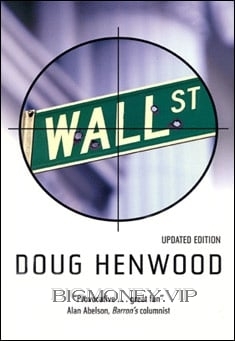Wall Street by Doug Henwood

1 Instruments
In February 1998, $1.4 trillion a day cr ossed the wire connecting the world’s
major banks. That figur e — which captures most of the world’s financial
action with the U.S. dollar on at least one side of the trade — was a mer e
$600 billion ar ound the time of the 1987 stock market crash. After that
inconsequential cataclysm, daily volume r esumed its mighty rise, passing
$800 billion in 1989, and $1 trillion in 1993 (Grant 1995, 1996). It is a pr o-
digious number: an amount equal to a year’s U.S. gr oss domestic product
(GDP) tur ns over in a week, and total world product in about a month.
Where does it all come from, and where does it go? Open the Wall
Street Journal or the business section of a major metropolitan daily, and
you get a clue. Every day, they publish an overwhelming array of price
quotes — thousands upon thousands — for stocks, bonds, currencies,
commodities, options, futures, options on futures, indexes, options on
indexes, mutual funds…. If you own a hundr ed shares of Iomega, or you’re
short wheat for April delivery, then you have no problem deciding what
they all mean — your money is at stake. But do all these prices, with acr es
of type and graphics devoted to analyzing and charting their often fe-
vered movements in loving detail, have any meaning beyond the narr owly
mercenary? Is the movement of the Dow, reported in about 30 seconds on
every evening network newscast, of interest to anyone besides the half of
the population that owns stocks, or the 1% of the population that owns
them in meaningful quantity? And do these price gyrations have any r ela-
tion to the other news reported in the paper or on TV — to the fate of
corporations, to the real standar d of living, to our public lives?
Figuring that out has to start with a pictur e of the elements of this finan-
cial universe — the instruments and institutions that construct the claims
that people make on each other over time and space. These claims are
denominated in money, the stuf f that economists study, but economists
forget that money is a form of social power. One of the persistent delu-
sions of conventional theory is that money is “neutral,” a lubricant with no
influence of its own, one that merely simplifies transactions in an economy
based on the exchange of goods.1 In a barter economy, the seller of wheat
would have to find a personal buyer; in a money economy, the wheat-
holder can sell for money, and let the system take care of the rest.
Money is a richer phenomenon than that explanation allows; it is one
of our fundamental principles of social or ganization. Ownership is r epre-
sented through monetary claims, and the exchange of those claims in the
financial markets amounts to the social construction of ownership.
Over the last decade or so, these “markets” — usually conveniently
referred to as an anonymous exter nal for ce, as pervasive and inevitable as
gravity — have gr own enormously. It’s a cliché of the daily press that the
markets ar e now more powerful than governments, that the daily votes
cast by the bond and curr ency markets ar e more important than elections,
legislatures, and public budgets. The cliché contains a partial truth: these
markets ar e tremendously powerful. But they ar e social institutions, in-
struments of power, that derive their power in part fr om the sense of pow-
erless awe they inspire among non-initiates. Say “the markets won’t like”
a minimum wage incr ease or a public jobs program, and critical scrutiny
often evaporates, like wishes crushed by the unfriendly voice of God.
While modern financial markets seem sublimely complex, they’r e es-
sentially composed of several basic instruments and institutional partici-
pants. Most of the instruments, despite their apparent novelty, are quite
old, their age measur ed better in centuries than decades.
What ar e these markets, and who populates them?
stocks
To many people, the stock market is Wall Str eet, and the New York Stock
Exchange (NYSE) is the stock market. A recent edition of Paul Samuelson’s
warhorse economics text even described the exchange as the “hub” of
capitalism, with no further explanation. Geography r einforces this per-
ception; the NYSE stands at the intersection of Broad and W all, at the spiri-
tual epicenter of Manhattan’s financial district. But in fact, stock market
trading volume is dwar fed by trading in bonds and for eign exchange, and
the NYSE itself accounts for a declining shar e of stock market volume.
These mere facts aside, there is some justification in giving the stock
market the prominence it enjoys in the popular mind. But one notion that




